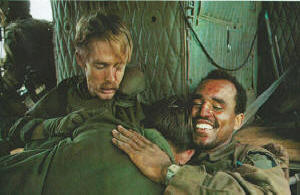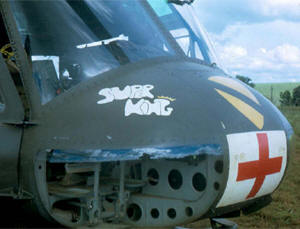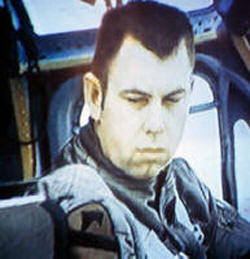War Stories 9
Enjoy the stories in this section. Some of them may even have been true!! Have a favorite war story you've been relating over the years? Well sit down
and shoot us a draft of it. Don't worry, we'll do our best to correct grammar, punctuation, and spelling before we publish it. to us and we'll publish them for all to enjoy.

Medevac
Sent by John Lonon
There is a mystique about Medevac. So much has been written of the
courage, the dedication and esprit de corps of the men in Medevac that today
they live with legend.
"It's why I joined the Army," said Medevac pilot Warrant Officer Richard
Leonard. "There's something about saving a life - and the way Medevac does
it, defying the odds - that makes it appealing."
"I've never seen a mission aborted," said SP4 Dick Gamester, who monitors
Medevac Control at Phouc Vinh. "I've seen missions delayed by weather and
suppressive fire, but never called off. There are nights when the only birds
in the sky are Medevac." The esprit de corps touches everyone. You can't get into the program
unless you volunteer, and even then the competition is tough.
SP4 Mike Vineyard, a helicopter mechanic at 15th Med, worked in a
maintenance shop before he got a shot at a crew chief position in Medevac.
"I frequently flew doorgunner when we'd go after a downed bird," he said. "You just do it." "When a bird goes down, everyone heads for the pad.
It's like a brotherhood."
That startling routine response to a call that seems beyond that of duty
is part of the mystique of Medevac. Yet there is another side. "It gets to be a little hairy at times," said Medevac pilot CPT Ernest
Bayford. "But I wouldn't say there's excessive strain on anyone." He's right, of course. Medevac teams lead a very comfortable life when
the going is slow. Half their time is free. Even at the brigade field
hospitals, where the teams are on call 24-hours a day, they have no duties
until suddenly, though routinely, they are called to scramble.
"Downed aircraft, let's go!" CPT Bayford shouted from the doorway of the
crew quarters. It was 2:21 p.m. and the scramble was on. The crew reached
the chopper at full stride; in minutes it was airborne, hitting 100 knots at
treetop level. The bird climbed to 2,000 feet; then nine minutes after the
call and 10 miles northeast of Quan Loi, the descent began.
They circled once at 300 feet as a Cobra gunship pulled in behind. The
downed aircraft was somewhere in the think green foliage below. A light
observation helicopter (LOH), flying as low as it could, finally spotted the
wreckage and marked it with purple smoke.
Aircraft commander Bayford banked the ship to the left and hovered over
the now visible downed helicopter, its slender tail protruding through the
bamboo. It was 2:33 when SP5 William Meeks attached the yellow, torpedo-like
jungle penetrator to the cable hoist and lowered it to the bamboo below.
On the ground a man grasped at it and, shielding his face from the
entangling brush, rode the cable skyward. He looked straight up at the
chopped with a strained smile, drawing closer, closer until he could touch
the skid, grab the medic's hand and pull himself aboard.
"We've got to get the pilot out! We've got to, got to!" he said again and
again, breathing hard as he lay against the cabin wall. The whine of the hoist started up again bringing the rescued doorgunner
to the side of the ship and inside. He clutched at the medic. It was 2:35
p.m. "He's trapped, I couldn't budge him. He waved me away," the man blurted
out. "We've got to get him out, we've got to." said the doorgunner. "They will. They will," answered the medic.
The ship gained altitude slowly, banked to the left and circled again at
300 feet. It was up to the Blues now - the crack infantry element of the 1st
Squadron 9th Cavalry, already airlifted into the area and maneuvering toward
the downed aircraft and its pinned pilot.
The Medevac chopped circled above. SP5 Meeks turned at once to his
patients, wrapping and taping the crushed toes of the doorgunner.
As the chopper passed over the crash site for the fourth time, a thick
cloud of white smoke erupted from the bamboo below, and there was a bright
red flash from the ground. "Hey, man our ship just blew up!" the wounded doorgunner shouted. He
turned to the medic with his eyes wide and fearful. The medic talked into
his radio mouthpiece, listened, and then looked at his patient.
"He's all right. The Blues got him out. He's okay."
The helicopter circled down to land in a yellow meadow close to the
crashed and burning chopper. The rescued
doorgunner looked past the medic. A big smile shot across his face as he
flashed the "V" sign at the freed pilot, now sprinting toward the ship. "You're the greatest. You're the greatest," the rescued pilot cried to
the Medevac crew as he climbed aboard. Then he turned and lunged at his own
two crew members who caught him in a wild embrace.



Super King Saves Lives
Sent by John Lonon
FSB David, Cambodia - "The Super King is the strongest ship we've got,"
said SP4 doorgunner Rick Goodson of the 1st Cavalry Division (Airmobile).
"It's always been able to do everything we've wanted it to do."
 On the last day of May, the Medevac bird for Co. A, 15th Med. Bn.,
working for the Cav's 1st Bde., ran its 747th mission of the month and
carried its 1500th infantryman to the rear for medical treatment.
On the last day of May, the Medevac bird for Co. A, 15th Med. Bn.,
working for the Cav's 1st Bde., ran its 747th mission of the month and
carried its 1500th infantryman to the rear for medical treatment.
The Cav's Super King is usually in the air minutes after being requested
by an infantry unit.
"Once we're in the air we find out the unit's location, the enemy
location, nature of the contact, number of injured, and the extent of their
injury. Also we have to coordinate with our companion gunship, and the air
controllers whose areas we pass over," Said LT Dennis Schmidt, the pilot of
Super King.
Approaching a pickup spot, the five men function as one. If the terrain
prevents landing, Goodson and SP4 crew chief David Morse lean out of their
gunwells to guide the sip as close to the ground as possible.
"We're in a constant state of correction when we're hovering. It's the
time when we're most unstable. That's why the people on the ground have to
be ready and do their best, "said Schmidt.
The infantrymen on the ground can make the job easier for Super King's
medic, too, said SP5 Mike Bodnar, who spent seven months in the field as a
medic with the 2nd Bn., 7th Cav., before extending to fly Medevac.
"We often have to keep him breathing when he doesn't want to breathe, and
keep him living when he doesn't want to live. The more they can do on the
ground for him, the better chance the serious patient has of making it,"
Bodnar said.
Although the crew's credo is that you shouldn't commit yourself to a
mission unless you think you can get out once you're in, many 1st Cav
infantrymen are alive today because of the men of Medevac.

In-country Checkride
By Ron (Baby Huey) Huether
As a young 23-year-old fresh out of Flight School Medical Service Corps
Second Lieutenant I was told (by every Vietnam era slick pilot) that I was
going to a chicken-shit Dustoff unit. Those same pilots also went on and on
about saving thousands of more patients than any Dustoff.
And so it was that I’m going through in-processing at Ben Hoa that I
notice an air ambulance land that had two M-60 machine guns mounted on it. I
nudged the personnel Warrant making assignments and asked him what unit
those cowboys belong to. He tells me, “Oh…that’s the Cav.” I immediately
tell him that’s the unit I want to be assigned to thinking how lucky I was
going to be. Not only was I going to have hot-and-cold running nurses at my
“MASH” unit, but I’d also have two M-60s to keep my young ass in relatively
one piece during my tour. Ahhhhhhhhh, dreams of a young Second Lieutenant
with shiny unscratched silver wings on his chest.
 One of the first events I had to attend during in-processing was throwing
a hand grenade on the range. Great, they didn’t teach hand grenades at the
Academy of Health Sciences (something about saving lives not taking them) so
I was jacked up.
One of the first events I had to attend during in-processing was throwing
a hand grenade on the range. Great, they didn’t teach hand grenades at the
Academy of Health Sciences (something about saving lives not taking them) so
I was jacked up.
Now I’m standing on the ready line and about to throw my
first hand grenade when one of those loony Cav air ambulances comes shooting
in and every NCO on the range is screaming, “Cease fire, cease fire!!” Out
pops the pilot from the right seat and he screams, “Is there a Lieutenant
Hoyther here?” I meekly stand up and say, “Are you looking for Lieutenant
Huether?” He screams that it was close enough and to get my ass in the back
of the Medevac.
It’s explained to me that Medevac had just lost some birds and
crewmembers in a place called Medevac Meadows and I was needed as ballast in
the right seat of Little Okie’s aircraft. So off to the Parrot’s Beak or
Fish Hook for some impromptu “this is how you conduct a Medevac” taught by
brother Hank Tuell.
All this sets the background for my hold baggage eventually catching up
to me a week later at Phuoc Vinh and being told I might have been good
looking ballast for Little Okie but I hadn’t had my in-country checkride.
And, I’m told, I ain’t a pilot until a something called Mr. Leonard
ssssssaaaayyyyys I’m a pilot.
So, the next day I meet this CW2 Leonard character and I can tell right
away I’m wearing the wrong brass to catch a break on any maneuver I might
need additional “coaching” on. We jump into an aircraft and off we go to
some abandoned French plantation airfield to conduct an in-country checkride
with this character mumbling into the intercom something about cherries and
damned RLOs.
I’m expecting the standard checkride – oral emergency procedure quizzing
followed by a hovering autorotation, and a litany of other normal emergency
procedures. Same-old-same-old ride I’ve aced my whole extensive aviation
career…all nine months.
Nope, that’s not what the checkride consisted of.
Leonard lands the helicopter at this old abandoned runway, then comes to a
hover, noses the aircraft over so the toes of the skids are about a
tenth-of-an-inch above the runway slamming the cyclic forward until the bird
is going 124 knots down the runway with the toes of the skids a pancakes
thickness off the runway. At 124 knots, he pulls the cyclic all the way
backwards and we shoot into the sky at some toward 1800 feet-per-minute rate
of climb. After about a minute we’re at a couple thousand feet and zero
airspeed when this jerk speaks into the intercom through is unkempt mustache
and says, “OK Lieutenant, you’ve got the controls.” As I grab the controls
he rolls off the throttle and says, “Now autorotate back to the airfield.”
Well, I had heard the phrase Assholes and Elbows before and even thought
I understood what the phrase meant – but not until that second did I REALLY
know the definition of Assholes and Elbows! Through pure luck and my butt
sucking so intently that I somehow found enough atmosphere to turn the bird
around and fall out of the sky back to the airfield with a “perfect” (OK,
three bounces) running landing.
And so it was, that this thing called Mr. Leonard signed me off as a
worthy member for the Dumb RLO Copilot ready roster.
[ Return To Index ]